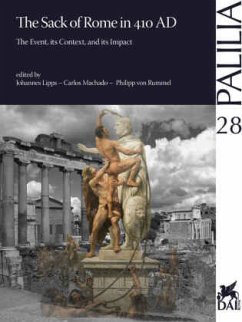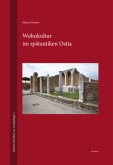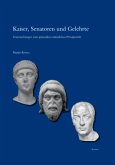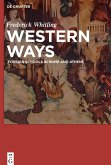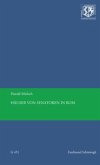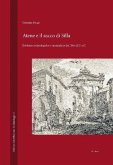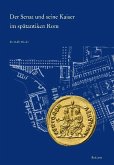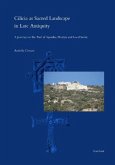On 24 August 410 the city of Rome the Goths led by their king Alaric captured and looted the city of Rome for three days. This was the first conquest of Rome in 800 years, an event that is full of symbolism and subject to great controversy. This book, based on a conference held at Rome in November 2010, offers a critical re-evaluation of all the evidence available, literary and archaeological, discussing not only what happened during those days, but also its context as well as its impact.
Hinweis: Dieser Artikel kann nur an eine deutsche Lieferadresse ausgeliefert werden.
Hinweis: Dieser Artikel kann nur an eine deutsche Lieferadresse ausgeliefert werden.
"The Sack of Rome est le volume le plus à jour sur la question du sac de Rome et des Goths. Tout étudiant ou chercheur qui s'intéresse de près ou de loin á la question des barbares de l'Antiquité tardive devra éventuellement feuilleter cet ouvrage, ne serait-ce que pour se désillusioner sur le sérieux des > commis par le plus célébre d'entre tous les groupes barbares."
Von: Patrick J. Roussel (Université de Montréal)
In: Cahiers D'Histoire, Volume XXXIV, N°2 - Été 2017, S. 193-196.
-----------------------------------------------------
"Der Band bietet viele anregende Impulse für die weitere Forschungsdiskussion, indem er verschiedene,
manchmal widersprüchliche Meinungen über die Bedeutung des Jahres 410 darstellt und zeigt, wie wertvoll
und effektiv die Untersuchung der historischen Phänomene mit Hilfe unterschiedlicher Quellentypen ist.
Besonders wichtig ist dabei, dass dieser Band wirklich eine kritische Synthese der für die ersten Dezennien
des fünften Jahrhunderts relevanten Befunde Roms bietet und auf diese Art und Weise zur weiteren Klärung längerfristiger Prozesse im fünften Jahrhundert beiträgt"
Von Dariusz Brodka
In: Bonner Jahrbücher Bd. 214 (2014), S. 455-457.
--------------------------------
"Am Ende steht zwar kein homogenes, aber doch ein zusammenhängendes Bild vor Augen, das viele Ergebnisse der Beiträge des Sammelbandes ineinandergreifen und nur weniges isoliert dastehen läßt. Das hat auch mit einer sorgfältigen Anordnung der Einzelabschnitte von den inhaltlich-methodischen Voraussetzungen über Kontextfragen und das Ereignis als solches bis zu dessen Folgen zu tun, nicht wenig auch mit einem geschickt angeordneten, Akzente setzenden Wechsel zwischen Aufsätzen mit grundsätzlichen Erwägungen und solchen, die Forschungen im Detail vorstellen. Sie halten den Leser weniger an, nach Widersprüchen zu suchen, als vielmehr, Vereinbarkeiten und Gemeinsamkeiten in der Sache, der sie sich widmen, zu durchdenken, gerade was die Bezüge zwischen dem Ereignis und dessen Auswirkungen betrifft. So werden, ausgehend von den Ereignissen Ende August 410, sehr gründlich die Auswirkungen auf die Geschichte des weströmischen Reiches im fünften Jahrhundert analysiert. Damit erweisen sich, zusammengenommen, die Aufsätze als ein willkommener Beitrag auch zum Verständnis der Existenzbedingungen Westroms im fünften Jahrhundert"
Von Ulrich Lambrecht
In: Plekos 17, 2015, S. 1-7.
-----------------------------------
"Erstmalig liegt nun eine erschöpfende Arbeit vor, die diejenige Quelle in den Vordergrund stellt, die (anders als die antiken Zeitgenossen oder ihre späteren Interpretatoren) tatsächlich »dabei gewesenee (17) sei, nämlich die urbs Roma selbst. Dadurch, dass der archäologische Befund in den Beiträgen niemals alleine präsentiert, sondern immer geschickt mit den Textquellen verbunden wird, gelang den drei Herausgebern eine Publikation, die für die Geschehnisse des Jahres 410 lange maßgeblich bleiben wird."
Von Kostantin M. Klein
In: Theologische Kiteraturzeitung 140, 2015, 3, S.238-239.
---------------------------------------
"This handsome volume of papers by many of the leading scholars of Late Antique Rome is based on a conference sponsored by the German Archaeological lnstitute in Rome in 2010 to mark the 1600th anniversary of the sack of Rome by Alaric's Visigoths. The goal of the conference was to reexamine the evidence for what actually happened in those fateful three days in August 410 and, more importantly, what impact those events had on the development of the city in the fifth century. While the editors disavow any claim to present a comprehensive inventory of the evidence or a definitive assessment of the events of 410, in fact the collected papers make substantial progress on both counts. The result is a volume that is essential reading not just for scholars interested in 410, but for anyone engaged in research on a wide variety of topics in the history, topography, and archaeology of Rome in the fifth century CE."
Von Robert Chenault
In: BMCR, 2014, 09, 27.
"This is a tremendously useful volume. Not only does it offer a state-of-the-art survey of archaeology of Rome in the age of Alaric. There are also larger interpretive payoffs. By directing our attention from the short-term physical effects of the sack (which were limited) to the longer-term cultural transformations initiated by it (which were profound), it offers a new perspective on the meaning of 410 as a historical event. Taken together, this volume marks an important advance in our understanding of the history of Rome in the early fifth century."
Von: John Weisweiler
In: sehepunkte 14, (2014), Nr. 11, http://www.sehepunkte.de/2014/11/druckfassung/24146.html, 04.12.2014.
Von: Patrick J. Roussel (Université de Montréal)
In: Cahiers D'Histoire, Volume XXXIV, N°2 - Été 2017, S. 193-196.
-----------------------------------------------------
"Der Band bietet viele anregende Impulse für die weitere Forschungsdiskussion, indem er verschiedene,
manchmal widersprüchliche Meinungen über die Bedeutung des Jahres 410 darstellt und zeigt, wie wertvoll
und effektiv die Untersuchung der historischen Phänomene mit Hilfe unterschiedlicher Quellentypen ist.
Besonders wichtig ist dabei, dass dieser Band wirklich eine kritische Synthese der für die ersten Dezennien
des fünften Jahrhunderts relevanten Befunde Roms bietet und auf diese Art und Weise zur weiteren Klärung längerfristiger Prozesse im fünften Jahrhundert beiträgt"
Von Dariusz Brodka
In: Bonner Jahrbücher Bd. 214 (2014), S. 455-457.
--------------------------------
"Am Ende steht zwar kein homogenes, aber doch ein zusammenhängendes Bild vor Augen, das viele Ergebnisse der Beiträge des Sammelbandes ineinandergreifen und nur weniges isoliert dastehen läßt. Das hat auch mit einer sorgfältigen Anordnung der Einzelabschnitte von den inhaltlich-methodischen Voraussetzungen über Kontextfragen und das Ereignis als solches bis zu dessen Folgen zu tun, nicht wenig auch mit einem geschickt angeordneten, Akzente setzenden Wechsel zwischen Aufsätzen mit grundsätzlichen Erwägungen und solchen, die Forschungen im Detail vorstellen. Sie halten den Leser weniger an, nach Widersprüchen zu suchen, als vielmehr, Vereinbarkeiten und Gemeinsamkeiten in der Sache, der sie sich widmen, zu durchdenken, gerade was die Bezüge zwischen dem Ereignis und dessen Auswirkungen betrifft. So werden, ausgehend von den Ereignissen Ende August 410, sehr gründlich die Auswirkungen auf die Geschichte des weströmischen Reiches im fünften Jahrhundert analysiert. Damit erweisen sich, zusammengenommen, die Aufsätze als ein willkommener Beitrag auch zum Verständnis der Existenzbedingungen Westroms im fünften Jahrhundert"
Von Ulrich Lambrecht
In: Plekos 17, 2015, S. 1-7.
-----------------------------------
"Erstmalig liegt nun eine erschöpfende Arbeit vor, die diejenige Quelle in den Vordergrund stellt, die (anders als die antiken Zeitgenossen oder ihre späteren Interpretatoren) tatsächlich »dabei gewesenee (17) sei, nämlich die urbs Roma selbst. Dadurch, dass der archäologische Befund in den Beiträgen niemals alleine präsentiert, sondern immer geschickt mit den Textquellen verbunden wird, gelang den drei Herausgebern eine Publikation, die für die Geschehnisse des Jahres 410 lange maßgeblich bleiben wird."
Von Kostantin M. Klein
In: Theologische Kiteraturzeitung 140, 2015, 3, S.238-239.
---------------------------------------
"This handsome volume of papers by many of the leading scholars of Late Antique Rome is based on a conference sponsored by the German Archaeological lnstitute in Rome in 2010 to mark the 1600th anniversary of the sack of Rome by Alaric's Visigoths. The goal of the conference was to reexamine the evidence for what actually happened in those fateful three days in August 410 and, more importantly, what impact those events had on the development of the city in the fifth century. While the editors disavow any claim to present a comprehensive inventory of the evidence or a definitive assessment of the events of 410, in fact the collected papers make substantial progress on both counts. The result is a volume that is essential reading not just for scholars interested in 410, but for anyone engaged in research on a wide variety of topics in the history, topography, and archaeology of Rome in the fifth century CE."
Von Robert Chenault
In: BMCR, 2014, 09, 27.
"This is a tremendously useful volume. Not only does it offer a state-of-the-art survey of archaeology of Rome in the age of Alaric. There are also larger interpretive payoffs. By directing our attention from the short-term physical effects of the sack (which were limited) to the longer-term cultural transformations initiated by it (which were profound), it offers a new perspective on the meaning of 410 as a historical event. Taken together, this volume marks an important advance in our understanding of the history of Rome in the early fifth century."
Von: John Weisweiler
In: sehepunkte 14, (2014), Nr. 11, http://www.sehepunkte.de/2014/11/druckfassung/24146.html, 04.12.2014.

